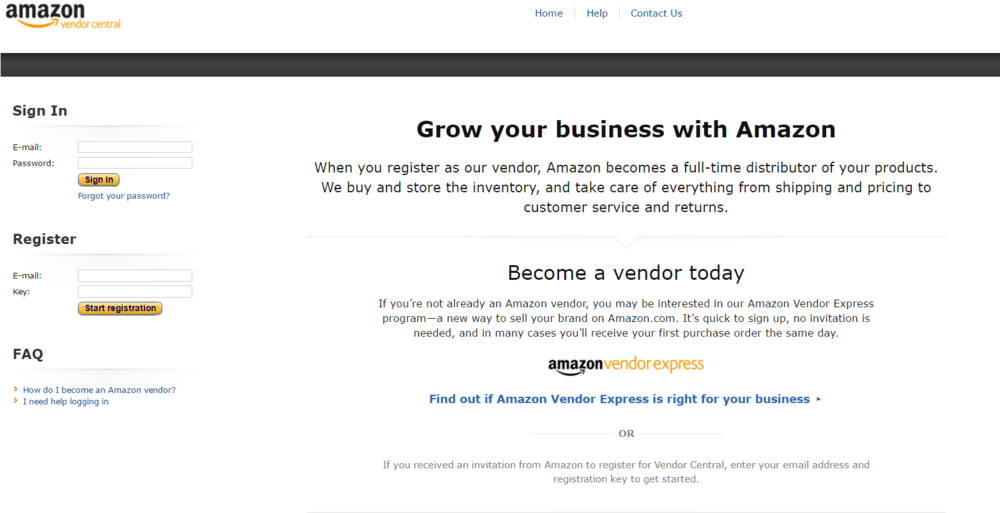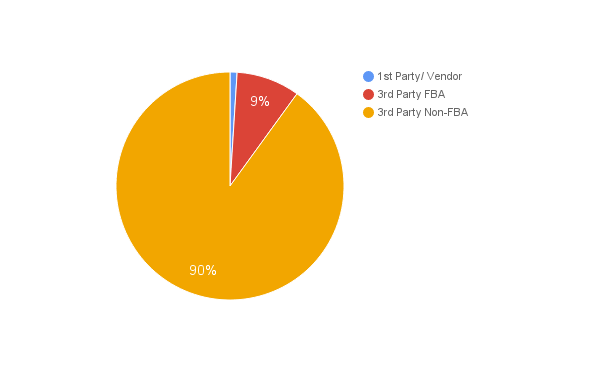So, you got an invite to Amazon’s Vendor program... but you don’t quite know if that’s the right program for you. In our blog post today, we help you better understand this opportunity, by sharing their knowledge from helping brands grow their revenue on Amazon Vendor Central & Vendor Express.
Amazon’s Vendor program, aka “1st Party/1P” is an invitation-based program that comes with attractive perks, but features downsides that makes it difficult for brand owners to decide whether or not this program will be the right choice for their business.
Being invited to the Vendor Central program is a recognition of your brand’s potential and fair play in the marketplace, as Amazon takes into account brands that have registered high sales while playing by the rules.

Above: Amazon Vendor Central Homepage
2 Ways to Sell on Amazon
Being a successful business in a marketplace with over 606 million product listings isn’t easy. For sellers that are currently struggling with their channel management, considering all available options to sell on Amazon is a good idea. There are 2 main ways to sell on Amazon, Vendor or Seller.
In the Vendor Program, your brand has a wholesale relationship with Amazon. Amazon makes Purchase Orders (PO) based on market demand, the brand fulfills the PO, and Amazon then basically handles the rest, from freight and shipping to customer service and even building your product detail pages. One of the biggest downsides is that you’ll be selling to Amazon at a wholesale rate (often a 50% discount on the selling price),
In the Seller Program (aka 3rd Party/3P), brands handle their channel by themselves, paying a percentage “referral fee” on each sale for the benefit of accessing Amazon’s customer base and for them to process the sale.
| Vendor, AKA "1st Party/1P"
- Wholesale relantioship with Amazon - Uses Vendor Central platform - Sell at a wholesale price (e.g. 50% discount to retail price) via Purchase Orders to Amazon - Amazon ships orders directly to customers (unless agreed otherweise)
|
Seller, AKA "3rd Party/3P"
- Marketplace Seller on Amazon - Uses Seller Central platform - Selling to Amazon's customers via their marketplace platform - Amazon charges 15% (most categories) on each sale - Merchants ship orders directly to customers or use Fulfilled by Amazon (FBA)
|
WHO SETS THE PRICE?
| VENDOR
- Amazon sets the price -Even if MAP (Minimum Advertised Price) policy is in place, Amazon will lower the selling price to the lowest advertised price online / in stores
|
SELLER
- Seller sets the price - Because Seller sets the price, pricing can be more easily maintained. However, since it is a marketplace, other Sellers can create offers to sell your products at a lower price
|
Which model does Amazon prefer?
Currently, around half of total sales on Amazon are from marketplace sellers, versus Vendors. Amazon says that they’re agnostic on the 2 models.
From a financial perspective, 3P is potentially more profitable for Amazon, because:
- There’s no COGS (Cost Of Goods Sold) on Amazon’s Balance Sheet
- Often the Seller warehouses the inventory, rather than Amazon, reducing storage & logistics costs*
- To maintain their Value Proposition, Amazon often matches the lowest price for Vendor products, which may be close to cost
*Source: ChannelAdvisor estimates that of the total 3rd Party SKUs, 36 million SKUs are FBA, versus around 300 million which are non-FBA.
Want to learn more about the Vendor program and how to use it effectively? Register for our free training course.
So why have 1P at all?
Amazon will always have 1P, even though their margin is probably lower. 1P products will occupy the Fat Head, and 3P will occupy the Long Tail. Amazon wants Fat Head products (brand name household items) to be 1P so they can closely control prices (be price competitive) & supply; but they also want the long tail that 3P enables. Out of 400 million SKUs, only 4 million would be 1P*.

Benefits of the Vendor program
- For Vendor Central, the ordering process is quite similar to the traditional brick & mortar - you negotiate broad terms upfront, then your Vendor Manager places Purchase Orders that you fill. Vendor Express operates under standard, non-negotiable terms and algorithm-based pricing.
- More difficult for other sellers to compete with your offers or make changes to product listings, since Amazon’s algorithm favors their own (Vendor) offers
- Access to AMS (Amazon Marketing Services) - Amazon’s more advanced advertising platform
- Visually optimized product listings & the Vine reviews program
Challenges with the Vendor Program
- Optimizing an assortment in Vendor Central & Vendor Express can be more challenging because of the limited interface and available support
- AMS is also more challenging to navigate than Sponsored Products (the Seller Central equivalent)
- Amazon may price products as they wish, potentially causing channel conflict
- Your Amazon Vendor Manager (or purchasing algorithm if on Vendor Express) may not place POs for all variations in your catalog
- Unexpected return fees & co-op fees can add up
Some brands find that FBA can be more profitable on some or all of their SKUs. It is possible to have both a Vendor and FBA account on Amazon.
How to take the right decision for your business?
Amazon’s Vendor Program comes with perks and downsides, for some businesses it could prove to be a profitable opportunity to grow their sales in the marketplace and a way to expand their distribution network with potentially less fuss than on Seller Central.
Bobsled Marketing works with Sellers and Vendors to grow their revenue and reach on Amazon’s marketplaces. Bobsled Marketing can help you assess if moving into Amazon’s Vendor program is a profitable choice for your business.
.png)

